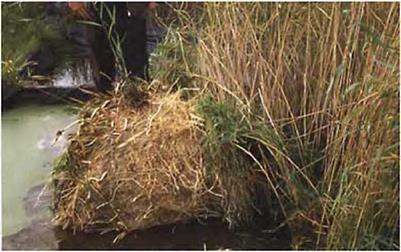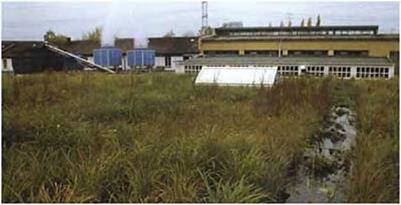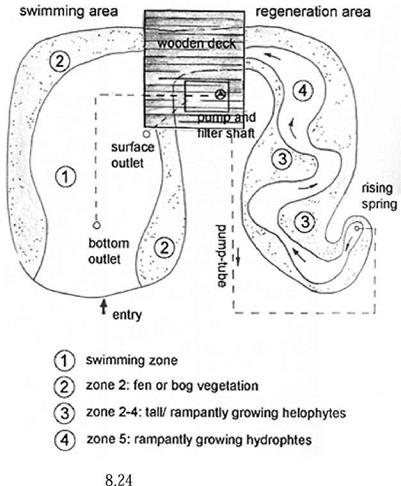If there is no possibility to establish plants in a pond’s swamp-zone, floating structures can be built as vegetation carriers. Figure 8.21 illustrates several possibilities for how to construct such drifting islands.
|
|
8.22
Coconut-fibre mat planted with Phragmites australis. The matting, thoroughly rooted through, is ready for installation along erosion – endangered shores
|
|
8.23
A roof garden on the Possmann cider factory (Frankfurt/Main,
Germany). Carex acutiformis and other helophytes are irrigated with circulating water which helps to cool the building and significantly reduces its electricity consumption
If they are fixed at the shore they then have the advantage of balancing fluctuating water levels by moving upwards and downwards, thereby guaranteeing a steady waterlevel for the planting. Any number of square metre sized elements with frames of timber, or even steel tubes, are used to establish reed vegetation on water reservoirs with heavy water – level variations (see Schltiter 1996:140-142). Figure 8.22 shows coconut fibre mats with reed-vegetation, ready to be established either to an erosion-threatened shore or between the frames of floating islands mentioned above. Large, extensive mats of floatable synthetic fabric (‘Repotex’) can cover purification ponds for contaminated water. Arnold and Mahlmann (2002) recommend planting Scirpus lacustris and Carex acuta (syn. C. gracilis) on to the mats.
On a smaller scale, floating islands can skirt ponds that have been built without wet – meadow and shallow-water zones. Here, for example, floating-styrofoam sheets—a special hard structured kind that cannot suck water—with fabric wicks passed through several holes can be used as a substrate carrier. A 5-10 cm substrate layer, covered and fixed by a coconut fibre-mat is sufficient to feed low and semi-high perennials, such as plants of fens or bogs. A floating bog is a recommended feature to brighten up open rainwater
|
|
A natural swimming pond system
reservoirs, particularly as the chemical quality of the water fits best to the vegetation of raised bogs.






